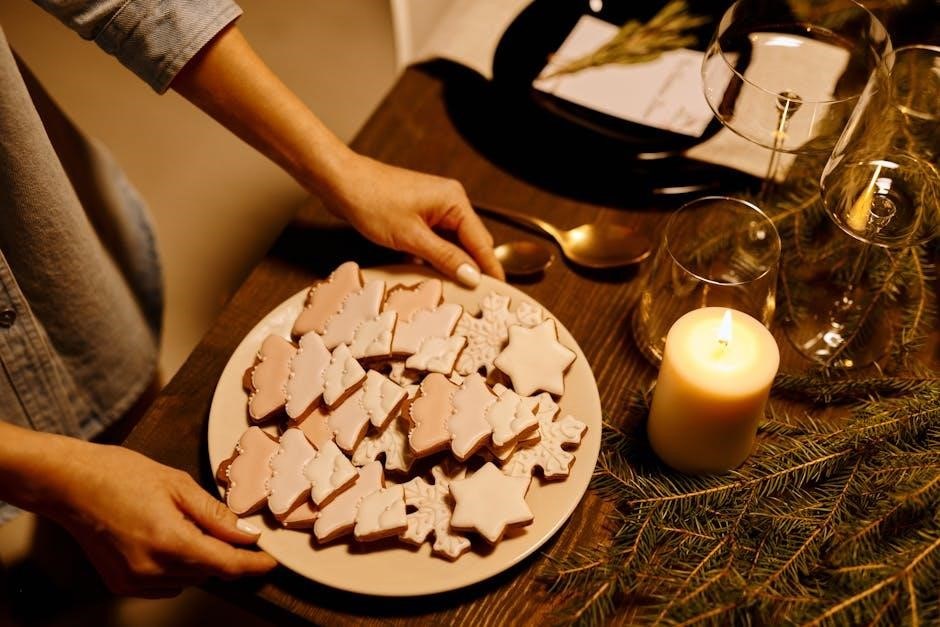A cake serving guide helps plan events by outlining standard sizes and servings, ensuring adequate portions for guests. It covers sizes, portion control, and serving factors.
Why a Cake Serving Guide is Essential
A cake serving guide is crucial for planning events, ensuring every guest receives an adequate portion. It helps avoid waste and guarantees enough slices for everyone, regardless of the occasion. By understanding standard sizes and servings, hosts can budget effectively and impress guests with perfectly sized treats. This guide eliminates guesswork, ensuring your celebration runs smoothly and everyone leaves satisfied.
How to Use This Guide Effectively
Start by determining your guest count and their appetite levels to estimate servings accurately. Choose the right cake size based on the number of servings needed. Use the guide to explore standard portion sizes and adjust for special events or dietary preferences. Refer to charts and calculators for precise measurements, and ensure accurate slicing for consistent servings. This approach guarantees a stress-free experience and delighted guests.
Standard Cake Serving Sizes
Standard cake serving sizes provide a baseline for planning, outlining typical diameters and corresponding servings to ensure consistent portion control for various events and gatherings.
Understanding Portion Sizes for Different Occasions
Portion sizes vary based on the event type, with weddings often requiring smaller, more elegant slices and casual gatherings allowing for larger servings. Guest appetite, event formality, and serving style also influence portion adjustments. For example, a wedding cake might use a “wedding cut” (1×2 inches), while a party cut could be bigger (1.5×3 inches). Understanding these differences ensures every guest receives an appropriate portion, balancing aesthetics and satisfaction.
Regular vs. Event-Specific Servings
Regular servings typically apply to everyday gatherings or small parties, offering standard slice sizes. Event-specific servings, like weddings or large celebrations, often require smaller, more uniform slices to accommodate larger groups. While regular servings focus on generous portions, event-specific servings prioritize consistency and presentation. Understanding these differences ensures the right balance between guest satisfaction and practicality, whether for intimate dinners or grand festivities.

Cake Sizes and Their Servings
Understanding cake sizes and their servings is crucial for event planning. Common diameters range from 6 to 12 inches, each yielding a specific number of portions.
Common Cake Diameters and Corresponding Servings
Standard cake diameters range from 6 to 12 inches, with servings varying accordingly. A 6-inch cake typically serves 6-8 guests, while an 8-inch serves 8-10. A 10-inch cake yields 12-15 servings, and a 12-inch cake serves 15-20. These sizes are ideal for weddings, parties, or small gatherings, ensuring everyone gets a fair portion. Using these diameters helps bakers and planners estimate accurately for any event.
How Height and Layers Affect Serving Numbers
Cake height and layers significantly impact serving numbers. Taller cakes or those with multiple layers generally yield more servings due to increased volume. Each additional layer can add 25-50% more servings, depending on height. However, slice thickness also plays a role, as thicker slices reduce the total count. Understanding this balance helps ensure accurate portion planning for events.
Factors Affecting Cake Servings
Factors affecting cake servings include slice size, serving style, and guest appetite, influencing portion control and ensuring cakes meet event demands effectively.
The Role of Cutting Style and Slice Size
The way a cake is cut significantly impacts serving numbers. Smaller, uniform slices increase yield, while larger cuts reduce servings. Techniques like even slicing and knife angle ensure consistency. Thicker slices satisfy heartier appetites, while thinner ones are ideal for formal events. Understanding this balance helps in portioning accurately, whether for weddings, parties, or intimate gatherings, ensuring every guest receives a fair share.
Guest Appetite and Event Type
Guest appetite and event type significantly influence serving sizes. For formal events or weddings, smaller, more delicate slices are often preferred, while casual gatherings may allow for larger portions. Time of day and meal context also matter—dessert slices after a full meal may be smaller than standalone treats. Understanding these dynamics helps tailor cake sizes to meet expectations and ensure satisfaction across diverse celebrations and guest preferences.

Tools for Accurate Serving Estimation
Tools like cake serving charts, calculators, and ingredient measuring guides ensure precise portion control, helping adjust recipes and guarantee accurate serving numbers for any event.
Using Cake Serving Charts and Calculators
Cake serving charts and calculators are essential tools for determining accurate portion sizes. They provide detailed guides based on cake diameter, height, and shape. These tools help estimate servings for various events, from weddings to parties. By inputting specific measurements, users can adjust for different serving styles, such as wedding cuts or party cuts. They also allow for scaling recipes up or down, ensuring the right amount of cake for any gathering. This makes planning events stress-free and efficient, guaranteeing enough for everyone.
Measuring Ingredients for Scaling Recipes
Accurate ingredient measurement is crucial when scaling cake recipes. Use a kitchen scale for precise quantities, especially for flour and sugar. Understanding pan volume helps adjust batter distribution. When scaling, consider ingredient ratios to maintain flavor balance. Adjusting leavening agents and liquids proportionally ensures even baking. Measure ingredients carefully to avoid over- or under-seasoning, ensuring consistency in taste and texture, regardless of cake size. This step guarantees successful scaling for any event or gathering.

Adjusting Cake Sizes for Special Events
Scaling recipes up or down ensures proper servings for events. Adjust ingredient quantities, baking time, and temperature to accommodate larger or smaller groups effectively.
Scaling Recipes for Larger or Smaller Groups
Scaling recipes ensures the right number of servings for any event. Adjust ingredient quantities proportionally, maintaining ratios for flour, sugar, eggs, and leavening agents. For larger groups, increase baking time slightly, while smaller batches may require shorter times. Temperature typically remains consistent, but monitoring is crucial for even baking. Measure ingredients accurately, especially when halving or tripling recipes, to ensure the cake’s texture and flavor remain consistent. This approach guarantees a perfect cake for any gathering size.
Timing and Temperature Adjustments for Different Sizes
Larger cakes require longer baking times due to increased thickness, while smaller cakes bake faster. Maintain consistent temperatures, but monitor closely to avoid overcooking. For larger sizes, extend baking time by 10-15% per additional layer or inch in diameter. Smaller cakes may need 25% less time. Use a thermometer to ensure accurate oven temperature, and adjust baking sheets for even airflow. This ensures uniform baking and prevents uneven cooking or drying out.
Common Mistakes in Cake Serving Calculations
Common mistakes include overestimating or underestimating servings based on cake size alone. Slice size, guest appetite, and event type significantly impact portion needs. Always measure slices and adjust for extras like frosting or decorations. Using standard serving charts helps, but consider individual preferences and serving styles to avoid leftovers or shortages. Double-check calculations to ensure every guest is adequately served without excess waste.
Overestimating or Underestimating Servings
Overestimating or underestimating servings is a common mistake when planning cake sizes. Many people rely solely on cake diameter without considering slice size, guest appetite, or event type. Large events often require smaller slices, while intimate gatherings may allow for larger portions. Using a cake serving chart can help, but it’s important to adjust for factors like frosting thickness and decorations, which can alter serving sizes. Always measure slices to ensure accuracy and avoid disappointing guests or wasting resources.
Neglecting to Account for Serving Style
Neglecting serving style can lead to inaccurate portion planning. For example, wedding cuts (small, uniform slices) yield more servings than party cuts (larger slices). Failing to consider how the cake will be served—such as whether it will be plated or served buffet-style—can result in insufficient slices or wasted cake. Always align serving style with the event format to ensure every guest is satisfied without over-preparing or underestimating needs.

Expert Tips for Perfect Cake Servings
Use professional slicing techniques for even portions. Scale recipes accurately and double-check serving numbers before baking. These strategies ensure consistent, delightful results for any event.
Professional Techniques for Even Slicing
For perfectly even slices, use a serrated knife and chill the cake to firm it up. Slice in smooth, steady strokes, using a ruler or guide for uniformity. Stabilize the cake with one hand while slicing. Clean the blade between cuts to prevent crumbs and tears. For layered cakes, slice through all layers at once, then separate. Always slice at room temperature for the cleanest cuts through both cake and frosting.
Final Checklists for Ensuring Adequate Servings
Confirm guest count and serving sizes before baking. Use a serving chart to match cake size to servings needed. Double-check measurements and ingredient ratios for scaling. Visually inspect the cake to ensure even slicing. Consider guest appetite and event type when finalizing portions. Keep extra servings or small cakes on standby. Ensure the cake is properly cooled and stable for slicing. Consult with your cake maker or team to verify all details.
